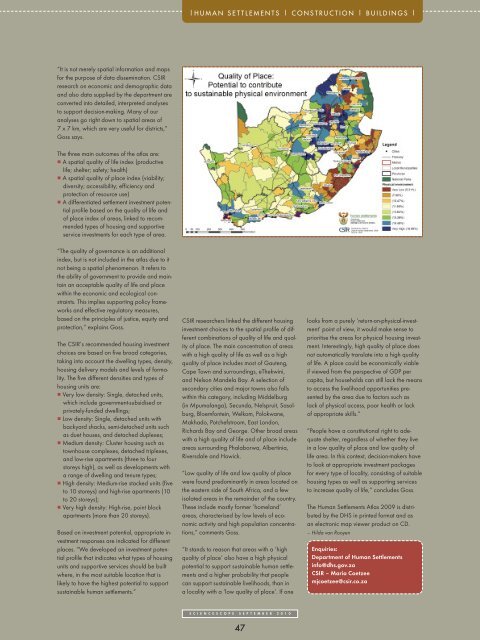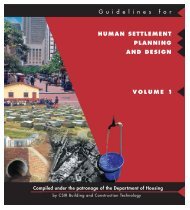guiding housing and human settlement investment - CSIR
guiding housing and human settlement investment - CSIR
guiding housing and human settlement investment - CSIR
You also want an ePaper? Increase the reach of your titles
YUMPU automatically turns print PDFs into web optimized ePapers that Google loves.
“It is not merely spatial information <strong>and</strong> maps<br />
for the purpose of data dissemination. <strong>CSIR</strong><br />
research on economic <strong>and</strong> demographic data<br />
<strong>and</strong> also data supplied by the department are<br />
converted into detailed, interpreted analyses<br />
to support decision-making. Many of our<br />
analyses go right down to spatial areas of<br />
7 x 7 km, which are very useful for districts,”<br />
Goss says.<br />
The three main outcomes of the atlas are:<br />
n A spatial quality of life index (productive<br />
life; shelter; safety; health)<br />
n A spatial quality of place index (viability;<br />
diversity; accessibility; efficiency <strong>and</strong><br />
protection of resource use)<br />
n A differentiated <strong>settlement</strong> <strong>investment</strong> potential<br />
profile based on the quality of life <strong>and</strong><br />
of place index of areas, linked to recommended<br />
types of <strong>housing</strong> <strong>and</strong> supportive<br />
service <strong>investment</strong>s for each type of area.<br />
“The quality of governance is an additional<br />
index, but is not included in the atlas due to it<br />
not being a spatial phenomenon. It refers to<br />
the ability of government to provide <strong>and</strong> maintain<br />
an acceptable quality of life <strong>and</strong> place<br />
within the economic <strong>and</strong> ecological constraints.<br />
This implies supporting policy frameworks<br />
<strong>and</strong> effective regulatory measures,<br />
based on the principles of justice, equity <strong>and</strong><br />
protection,” explains Goss.<br />
The <strong>CSIR</strong>’s recommended <strong>housing</strong> <strong>investment</strong><br />
choices are based on five broad categories,<br />
taking into account the dwelling types, density,<br />
<strong>housing</strong> delivery models <strong>and</strong> levels of formality.<br />
The five different densities <strong>and</strong> types of<br />
<strong>housing</strong> units are:<br />
n Very low density: Single, detached units,<br />
which include government-subsidised or<br />
privately-funded dwellings;<br />
n Low density: Single, detached units with<br />
backyard shacks, semi-detached units such<br />
as duet houses, <strong>and</strong> detached duplexes;<br />
n Medium density: Cluster <strong>housing</strong> such as<br />
townhouse complexes, detached triplexes,<br />
<strong>and</strong> low-rise apartments (three to four<br />
storeys high), as well as developments with<br />
a range of dwelling <strong>and</strong> tenure types;<br />
n High density: Medium-rise stacked units (five<br />
to 10 storeys) <strong>and</strong> high-rise apartments (10<br />
to 20 storeys);<br />
n Very high density: High-rise, point block<br />
apartments (more than 20 storeys).<br />
Based on <strong>investment</strong> potential, appropriate <strong>investment</strong><br />
responses are indicated for different<br />
places. “We developed an <strong>investment</strong> potential<br />
profile that indicates what types of <strong>housing</strong><br />
units <strong>and</strong> supportive services should be built<br />
where, in the most suitable location that is<br />
likely to have the highest potential to support<br />
sustainable <strong>human</strong> <strong>settlement</strong>s.”<br />
| H U M A N S E T T L E M E N T S | C O N S T R U C T I O N | B U I L D I N G S |<br />
<strong>CSIR</strong> researchers linked the different <strong>housing</strong><br />
<strong>investment</strong> choices to the spatial profile of different<br />
combinations of quality of life <strong>and</strong> quality<br />
of place. The main concentration of areas<br />
with a high quality of life as well as a high<br />
quality of place includes most of Gauteng,<br />
Cape Town <strong>and</strong> surroundings, eThekwini,<br />
<strong>and</strong> Nelson M<strong>and</strong>ela Bay. A selection of<br />
secondary cities <strong>and</strong> major towns also falls<br />
within this category, including Middelburg<br />
(in Mpumalanga), Secunda, Nelspruit, Sasolburg,<br />
Bloemfontein, Welkom, Polokwane,<br />
Makhado, Potchefstroom, East London,<br />
Richards Bay <strong>and</strong> George. Other broad areas<br />
with a high quality of life <strong>and</strong> of place include<br />
areas surrounding Phalaborwa, Albertinia,<br />
Riversdale <strong>and</strong> Howick.<br />
“Low quality of life <strong>and</strong> low quality of place<br />
were found predominantly in areas located on<br />
the eastern side of South Africa, <strong>and</strong> a few<br />
isolated areas in the remainder of the country.<br />
These include mostly former ‘homel<strong>and</strong>’<br />
areas, characterised by low levels of economic<br />
activity <strong>and</strong> high population concentrations,”<br />
comments Goss.<br />
“It st<strong>and</strong>s to reason that areas with a ‘high<br />
quality of place’ also have a high physical<br />
potential to support sustainable <strong>human</strong> <strong>settlement</strong>s<br />
<strong>and</strong> a higher probability that people<br />
can support sustainable livelihoods, than in<br />
a locality with a ‘low quality of place’. If one<br />
S C I E N C E S C O P E S E P T E M B E R 2 0 1 0<br />
47<br />
looks from a purely ‘return-on-physical-<strong>investment</strong>’<br />
point of view, it would make sense to<br />
prioritise the areas for physical <strong>housing</strong> <strong>investment</strong>.<br />
Interestingly, high quality of place does<br />
not automatically translate into a high quality<br />
of life. A place could be economically viable<br />
if viewed from the perspective of GDP per<br />
capita, but households can still lack the means<br />
to access the livelihood opportunities presented<br />
by the area due to factors such as<br />
lack of physical access, poor health or lack<br />
of appropriate skills.”<br />
“People have a constitutional right to adequate<br />
shelter, regardless of whether they live<br />
in a low quality of place <strong>and</strong> low quality of<br />
life area. In this context, decision-makers have<br />
to look at appropriate <strong>investment</strong> packages<br />
for every type of locality, consisting of suitable<br />
<strong>housing</strong> types as well as supporting services<br />
to increase quality of life,” concludes Goss.<br />
The Human Settlements Atlas 2009 is distributed<br />
by the DHS in printed format <strong>and</strong> as<br />
an electronic map viewer product on CD.<br />
– Hilda van Rooyen<br />
Enquiries:<br />
Department of Human Settlements<br />
info@dhs.gov.za<br />
<strong>CSIR</strong> – Maria Coetzee<br />
mjcoetzee@csir.co.za

















